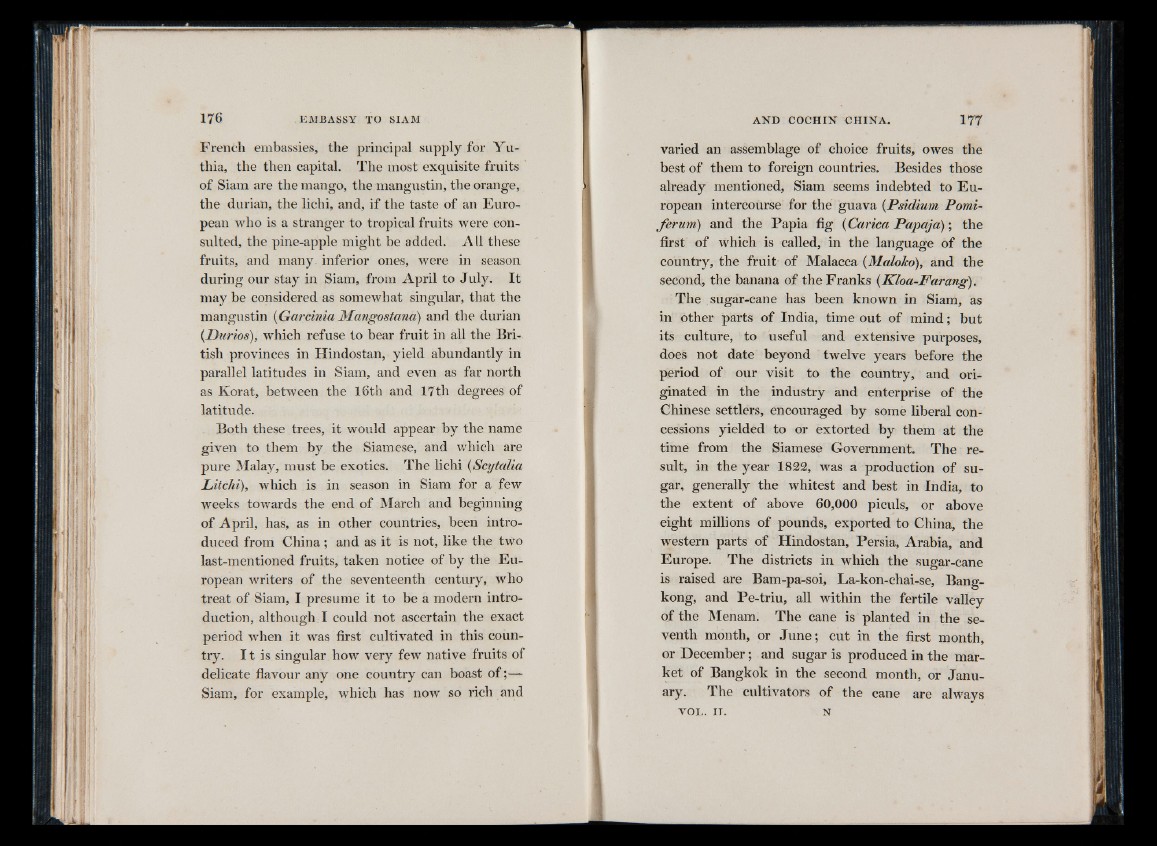
French embassies, the principal supply for Yu-
thia, the then capital. The most exquisite fruits
of Siam are the mango, the mangustin, the orange,
the durian, the lichi, and, if the taste of an European
who is a stranger to tropical fruits were consulted,
the pine-apple might be added. All these
fruits, and many inferior ones, were in season
during our stay in Siam, from April to July. It
may be considered as somewhat singular, that the
mangustin (Garcinia Mangostana) and the durian
(Durios), which refuse to bear fruit in all the British
provinces in Hindostan, yield abundantly in
parallel latitudes in Siam, and even as far north
as Korat, between the 16th and 17th degrees of
latitude.
Both these trees, it would appear by the name
given to them by the Siamese, and which are
pure Malay, must be exotics. The lichi (Scytalia
Litchi), which is in season in Siam for a few
weeks towards the end of March and beginning
of April, has, as in other countries, been introduced
from China ; and as it is not, like the two
last-mentioned fruits, taken notice of by the E u ropean
writers of the seventeenth century, who
treat of Siam, I presume it to be a modern introduction,
although I could not ascertain the exact
period when it was first cultivated in this country.
11 is singular how very few native fruits of
delicate flavour any one country can boast o f;—
Siam, for example, which has now so rich and
varied an assemblage of choice fruits, owes the
best of them to foreign countries. Besides those
already mentioned, Siam seems indebted to European
intercourse for the guava (Psidiutn Pomi-
J'erum) and the Papia fig (Carica Papaja); the
first of which is called, in the language of the
country, the fruit of Malacca (Maloko), and the
second, the banana of the Franks (Kloa-Farang).
The sugar-cane has been known in Siam, as
in other parts of India, time out of mind; but
its culture, to useful and extensive purposes,
does not date beyond twelve years before the
period of our visit to the country, and originated
in the industry and enterprise of the
Chinese settlers, encouraged by some liberal concessions
yielded to or extorted by them at the
time from the Siamese Government. The result,
in the year 1822, was a production of sugar,
generally the whitest and best in India, to
the extent of above 60,000 piculs, or above
eight millions of pounds, exported to China, the
western parts of Hindostan, Persia, Arabia, and
Europe. The districts in which the sugar-cane
is raised are Bam-pa-soi, La-kon-chai-se, Bang-
kong, and Pe-triu, all within the fertile valley
of the Menam. The cane is planted in the seventh
month, or Ju n e ; cut in the first month,
or December; and sugar is produced in the market
of Bangkok in the second month, or January.
The cultivators of the cane are always
VOL. I I . N